FORD FOCUS 2013 3.G Workshop Manual
Manufacturer: FORD, Model Year: 2013, Model line: FOCUS, Model: FORD FOCUS 2013 3.GPages: 475, PDF Size: 5.55 MB
Page 51 of 475
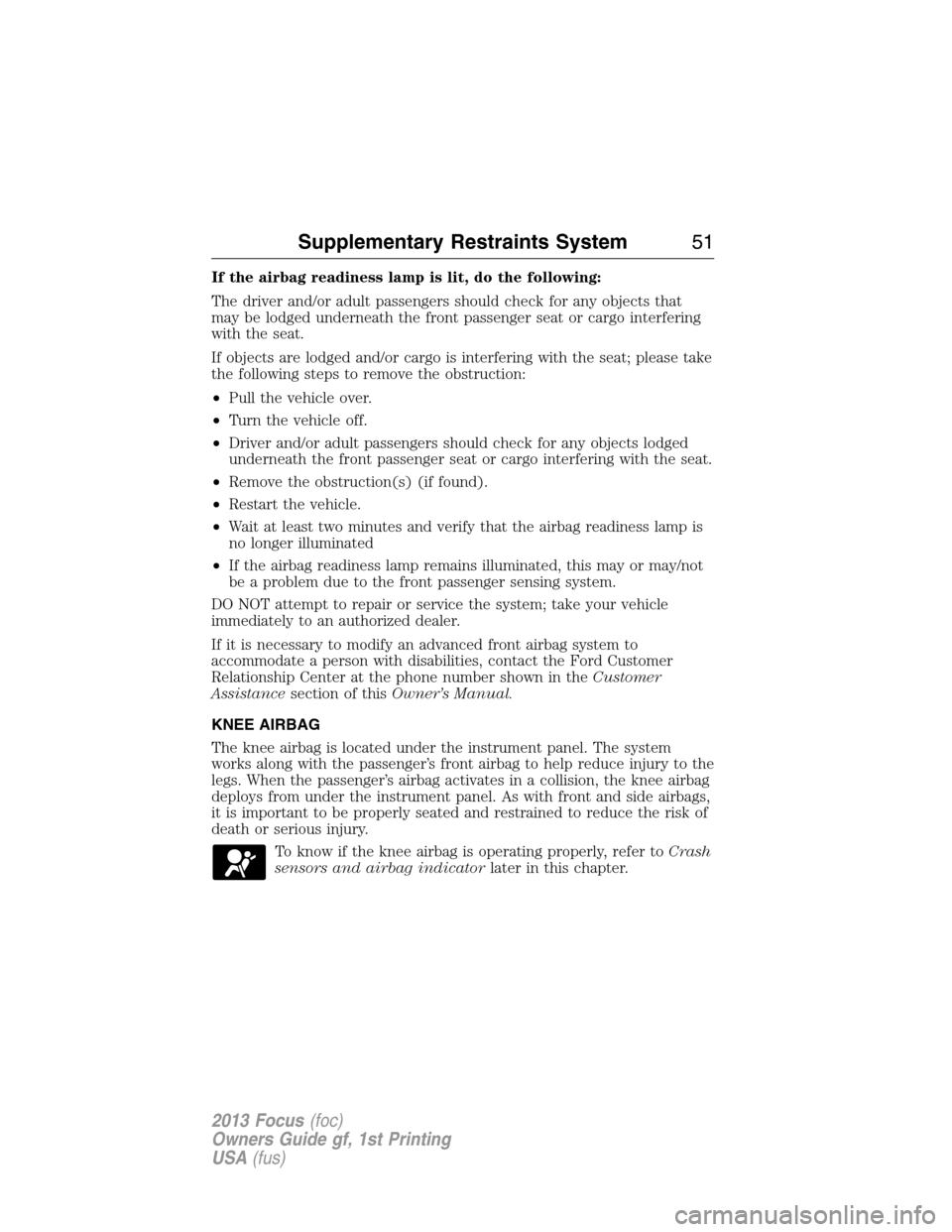
If the airbag readiness lamp is lit, do the following:
The driver and/or adult passengers should check for any objects that
may be lodged underneath the front passenger seat or cargo interfering
with the seat.
If objects are lodged and/or cargo is interfering with the seat; please take
the following steps to remove the obstruction:
•Pull the vehicle over.
•Turn the vehicle off.
•Driver and/or adult passengers should check for any objects lodged
underneath the front passenger seat or cargo interfering with the seat.
•Remove the obstruction(s) (if found).
•Restart the vehicle.
•Wait at least two minutes and verify that the airbag readiness lamp is
no longer illuminated
•If the airbag readiness lamp remains illuminated, this may or may/not
be a problem due to the front passenger sensing system.
DO NOT attempt to repair or service the system; take your vehicle
immediately to an authorized dealer.
If it is necessary to modify an advanced front airbag system to
accommodate a person with disabilities, contact the Ford Customer
Relationship Center at the phone number shown in theCustomer
Assistancesection of thisOwner’s Manual.
KNEE AIRBAG
The knee airbag is located under the instrument panel. The system
works along with the passenger’s front airbag to help reduce injury to the
legs. When the passenger’s airbag activates in a collision, the knee airbag
deploys from under the instrument panel. As with front and side airbags,
it is important to be properly seated and restrained to reduce the risk of
death or serious injury.
To know if the knee airbag is operating properly, refer toCrash
sensors and airbag indicatorlater in this chapter.
Supplementary Restraints System51
2013 Focus(foc)
Owners Guide gf, 1st Printing
USA(fus)
Page 52 of 475
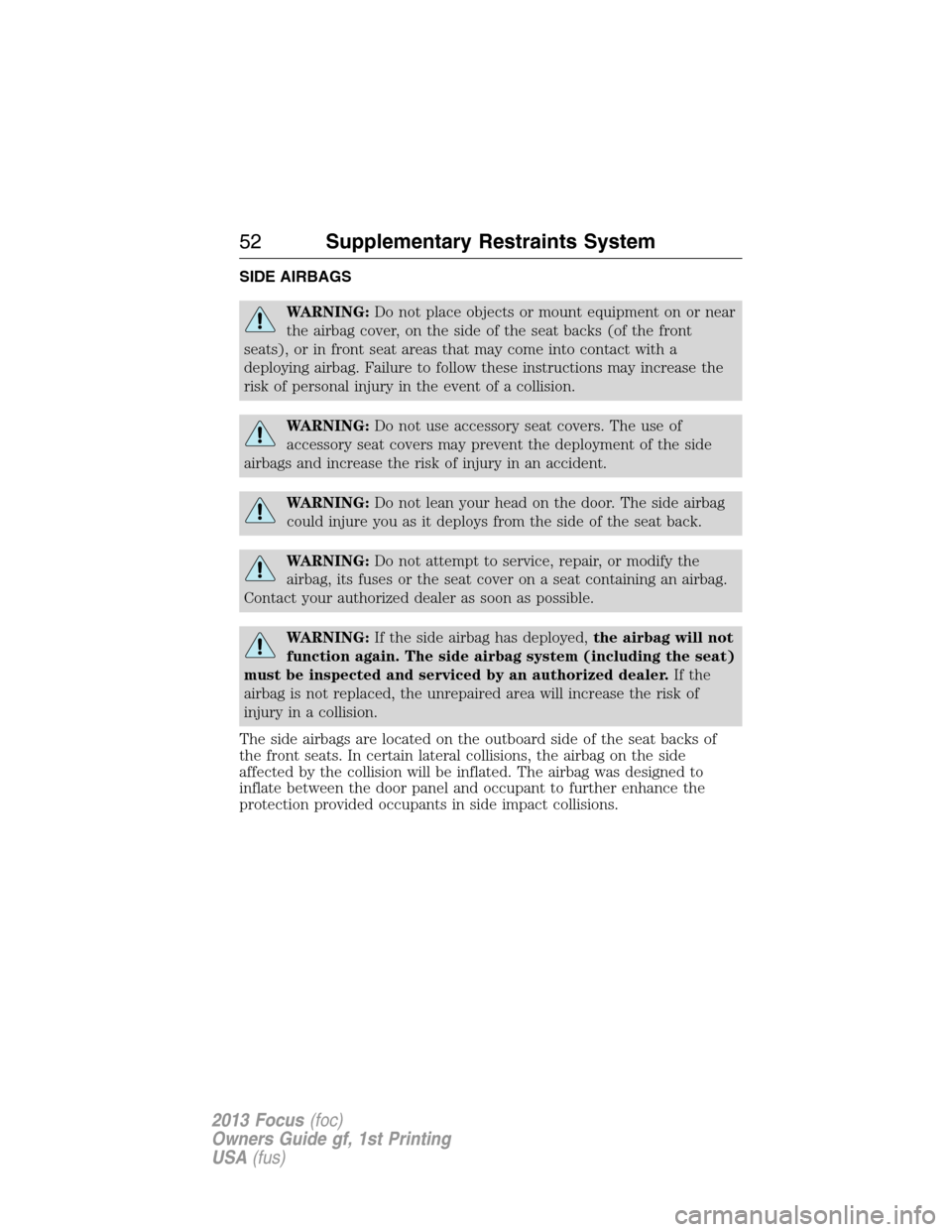
SIDE AIRBAGS
WARNING:Do not place objects or mount equipment on or near
the airbag cover, on the side of the seat backs (of the front
seats), or in front seat areas that may come into contact with a
deploying airbag. Failure to follow these instructions may increase the
risk of personal injury in the event of a collision.
WARNING:Do not use accessory seat covers. The use of
accessory seat covers may prevent the deployment of the side
airbags and increase the risk of injury in an accident.
WARNING:Do not lean your head on the door. The side airbag
could injure you as it deploys from the side of the seat back.
WARNING:Do not attempt to service, repair, or modify the
airbag, its fuses or the seat cover on a seat containing an airbag.
Contact your authorized dealer as soon as possible.
WARNING:If the side airbag has deployed,the airbag will not
function again. The side airbag system (including the seat)
must be inspected and serviced by an authorized dealer.If the
airbag is not replaced, the unrepaired area will increase the risk of
injury in a collision.
The side airbags are located on the outboard side of the seat backs of
the front seats. In certain lateral collisions, the airbag on the side
affected by the collision will be inflated. The airbag was designed to
inflate between the door panel and occupant to further enhance the
protection provided occupants in side impact collisions.
52Supplementary Restraints System
2013 Focus(foc)
Owners Guide gf, 1st Printing
USA(fus)
Page 53 of 475
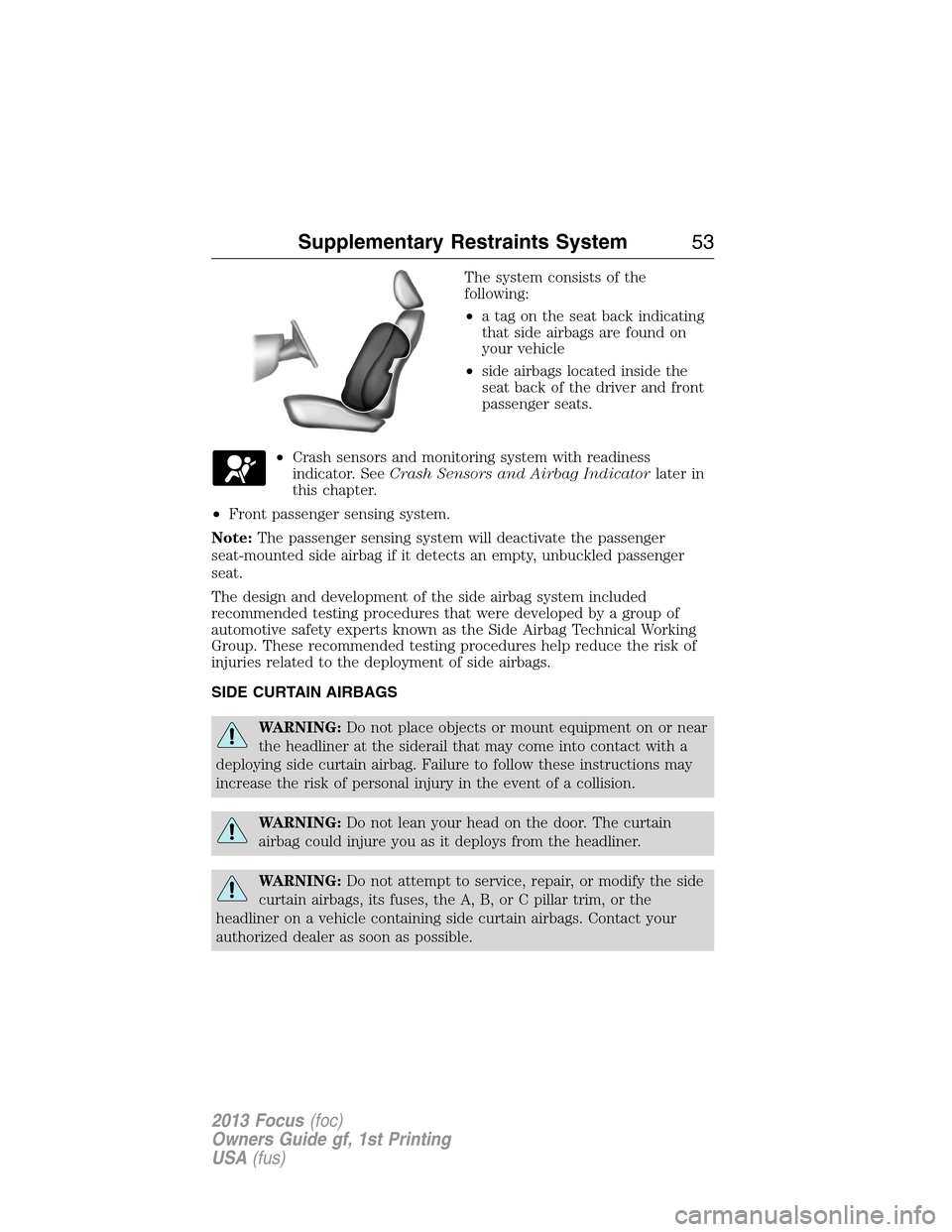
The system consists of the
following:
•a tag on the seat back indicating
that side airbags are found on
your vehicle
•side airbags located inside the
seat back of the driver and front
passenger seats.
•Crash sensors and monitoring system with readiness
indicator. SeeCrash Sensors and Airbag Indicatorlater in
this chapter.
•Front passenger sensing system.
Note:The passenger sensing system will deactivate the passenger
seat-mounted side airbag if it detects an empty, unbuckled passenger
seat.
The design and development of the side airbag system included
recommended testing procedures that were developed by a group of
automotive safety experts known as the Side Airbag Technical Working
Group. These recommended testing procedures help reduce the risk of
injuries related to the deployment of side airbags.
SIDE CURTAIN AIRBAGS
WARNING:Do not place objects or mount equipment on or near
the headliner at the siderail that may come into contact with a
deploying side curtain airbag. Failure to follow these instructions may
increase the risk of personal injury in the event of a collision.
WARNING:Do not lean your head on the door. The curtain
airbag could injure you as it deploys from the headliner.
WARNING:Do not attempt to service, repair, or modify the side
curtain airbags, its fuses, the A, B, or C pillar trim, or the
headliner on a vehicle containing side curtain airbags. Contact your
authorized dealer as soon as possible.
Supplementary Restraints System53
2013 Focus(foc)
Owners Guide gf, 1st Printing
USA(fus)
Page 54 of 475

WARNING:All occupants of the vehicle including the driver
should always wear their safety belts even when an airbag SRS
and side curtain airbag is provided.
WARNING:To reduce risk of injury, do not obstruct or place
objects in the deployment path of the side curtain airbag.
WARNING:If the side curtain airbags have deployed,the side
curtain airbags will not function again. The side curtain
airbags (including the A, B and C pillar trim and headliner)
must be inspected and serviced by an authorized dealer.If the
side curtain airbag is not replaced, the unrepaired area will increase the
risk of injury in a collision.
A side curtain airbag will deploy during significant side collisions. The
side curtain airbags are mounted to the roof side-rail sheet metal, behind
the headliner, above each row of seats. In certain lateral collisions, the
side curtain airbag on the impacted side of the vehicle will be activated.
The side curtain airbags are designed to inflate between the side window
area and occupants to further enhance protection provided in side
impact collisions.
The system consists of the
following:
•Side curtain airbags located
above the trim panels over the
front and rear side windows
identified by a label or wording
on the headliner or roof-pillar
trim.
•A flexible headliner which opens above the side doors to allow side air
curtain deployment.
•Crash sensors and monitoring system with readiness
indicator. Refer toCrash sensors and Airbag Indicator
later in this chapter.
54Supplementary Restraints System
2013 Focus(foc)
Owners Guide gf, 1st Printing
USA(fus)
Page 55 of 475
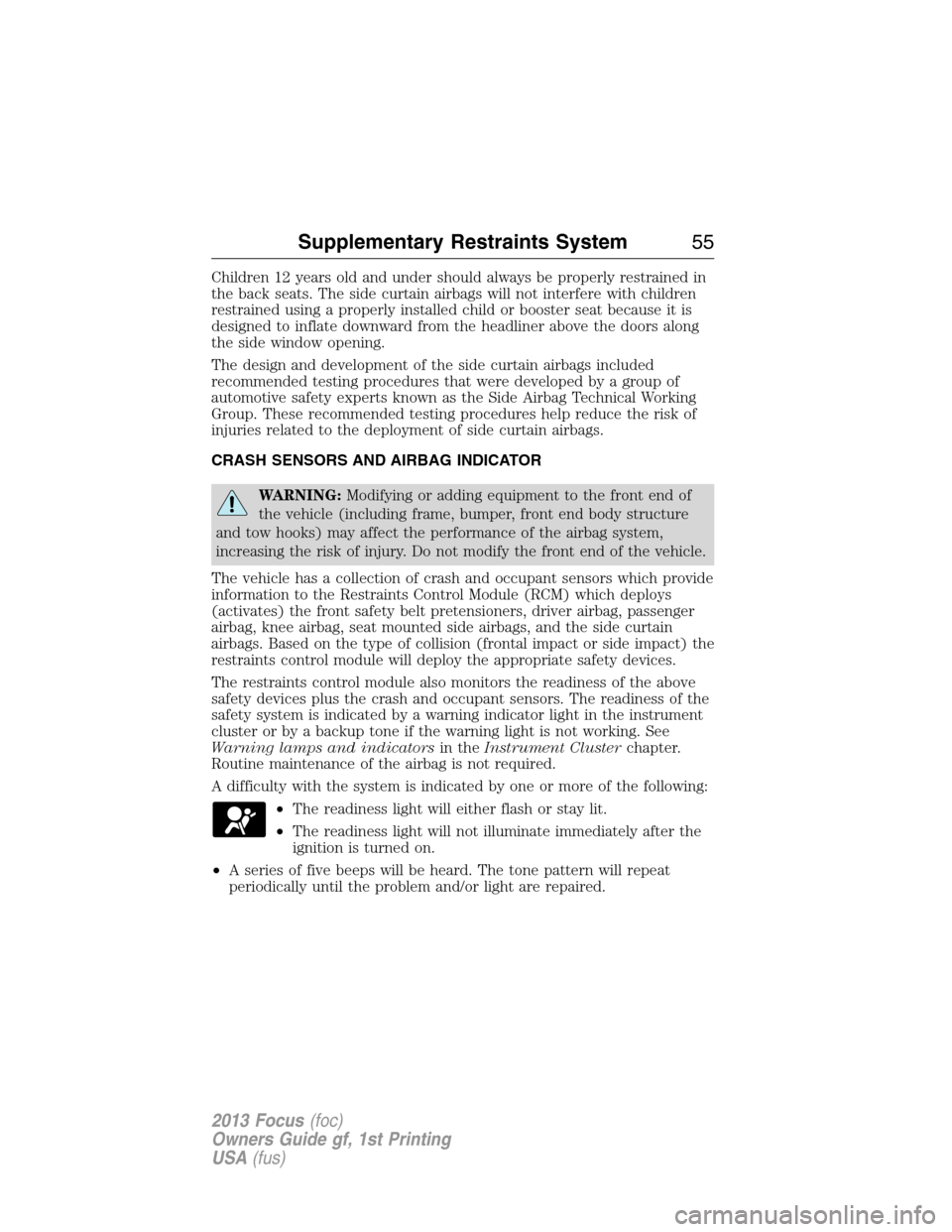
Children 12 years old and under should always be properly restrained in
the back seats. The side curtain airbags will not interfere with children
restrained using a properly installed child or booster seat because it is
designed to inflate downward from the headliner above the doors along
the side window opening.
The design and development of the side curtain airbags included
recommended testing procedures that were developed by a group of
automotive safety experts known as the Side Airbag Technical Working
Group. These recommended testing procedures help reduce the risk of
injuries related to the deployment of side curtain airbags.
CRASH SENSORS AND AIRBAG INDICATOR
WARNING:Modifying or adding equipment to the front end of
the vehicle (including frame, bumper, front end body structure
and tow hooks) may affect the performance of the airbag system,
increasing the risk of injury. Do not modify the front end of the vehicle.
The vehicle has a collection of crash and occupant sensors which provide
information to the Restraints Control Module (RCM) which deploys
(activates) the front safety belt pretensioners, driver airbag, passenger
airbag, knee airbag, seat mounted side airbags, and the side curtain
airbags. Based on the type of collision (frontal impact or side impact) the
restraints control module will deploy the appropriate safety devices.
The restraints control module also monitors the readiness of the above
safety devices plus the crash and occupant sensors. The readiness of the
safety system is indicated by a warning indicator light in the instrument
cluster or by a backup tone if the warning light is not working. See
Warning lamps and indicatorsin theInstrument Clusterchapter.
Routine maintenance of the airbag is not required.
A difficulty with the system is indicated by one or more of the following:
•The readiness light will either flash or stay lit.
•The readiness light will not illuminate immediately after the
ignition is turned on.
•A series of five beeps will be heard. The tone pattern will repeat
periodically until the problem and/or light are repaired.
Supplementary Restraints System55
2013 Focus(foc)
Owners Guide gf, 1st Printing
USA(fus)
Page 56 of 475
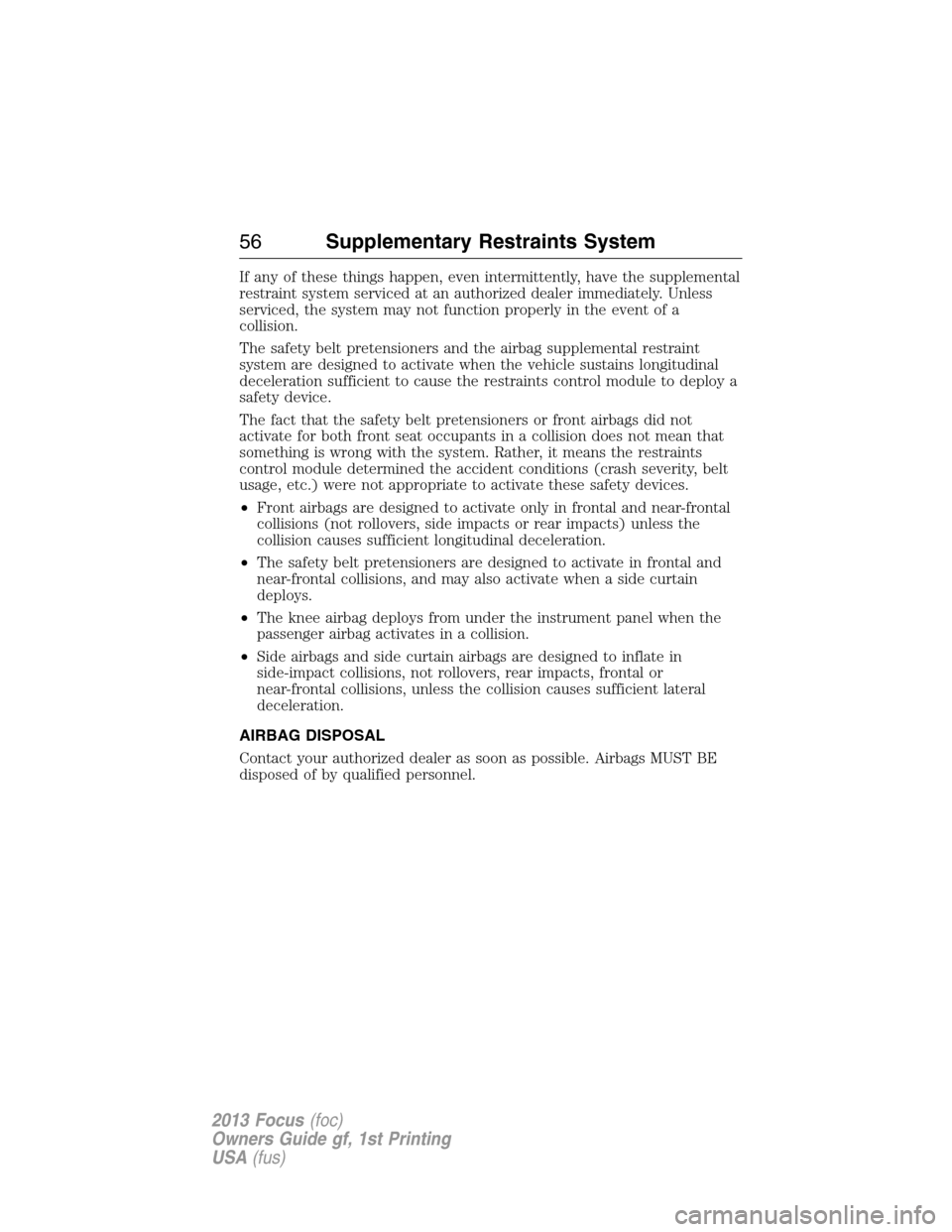
If any of these things happen, even intermittently, have the supplemental
restraint system serviced at an authorized dealer immediately. Unless
serviced, the system may not function properly in the event of a
collision.
The safety belt pretensioners and the airbag supplemental restraint
system are designed to activate when the vehicle sustains longitudinal
deceleration sufficient to cause the restraints control module to deploy a
safety device.
The fact that the safety belt pretensioners or front airbags did not
activate for both front seat occupants in a collision does not mean that
something is wrong with the system. Rather, it means the restraints
control module determined the accident conditions (crash severity, belt
usage, etc.) were not appropriate to activate these safety devices.
•Front airbags are designed to activate only in frontal and near-frontal
collisions (not rollovers, side impacts or rear impacts) unless the
collision causes sufficient longitudinal deceleration.
•The safety belt pretensioners are designed to activate in frontal and
near-frontal collisions, and may also activate when a side curtain
deploys.
•The knee airbag deploys from under the instrument panel when the
passenger airbag activates in a collision.
•Side airbags and side curtain airbags are designed to inflate in
side-impact collisions, not rollovers, rear impacts, frontal or
near-frontal collisions, unless the collision causes sufficient lateral
deceleration.
AIRBAG DISPOSAL
Contact your authorized dealer as soon as possible. Airbags MUST BE
disposed of by qualified personnel.
56Supplementary Restraints System
2013 Focus(foc)
Owners Guide gf, 1st Printing
USA(fus)
Page 57 of 475
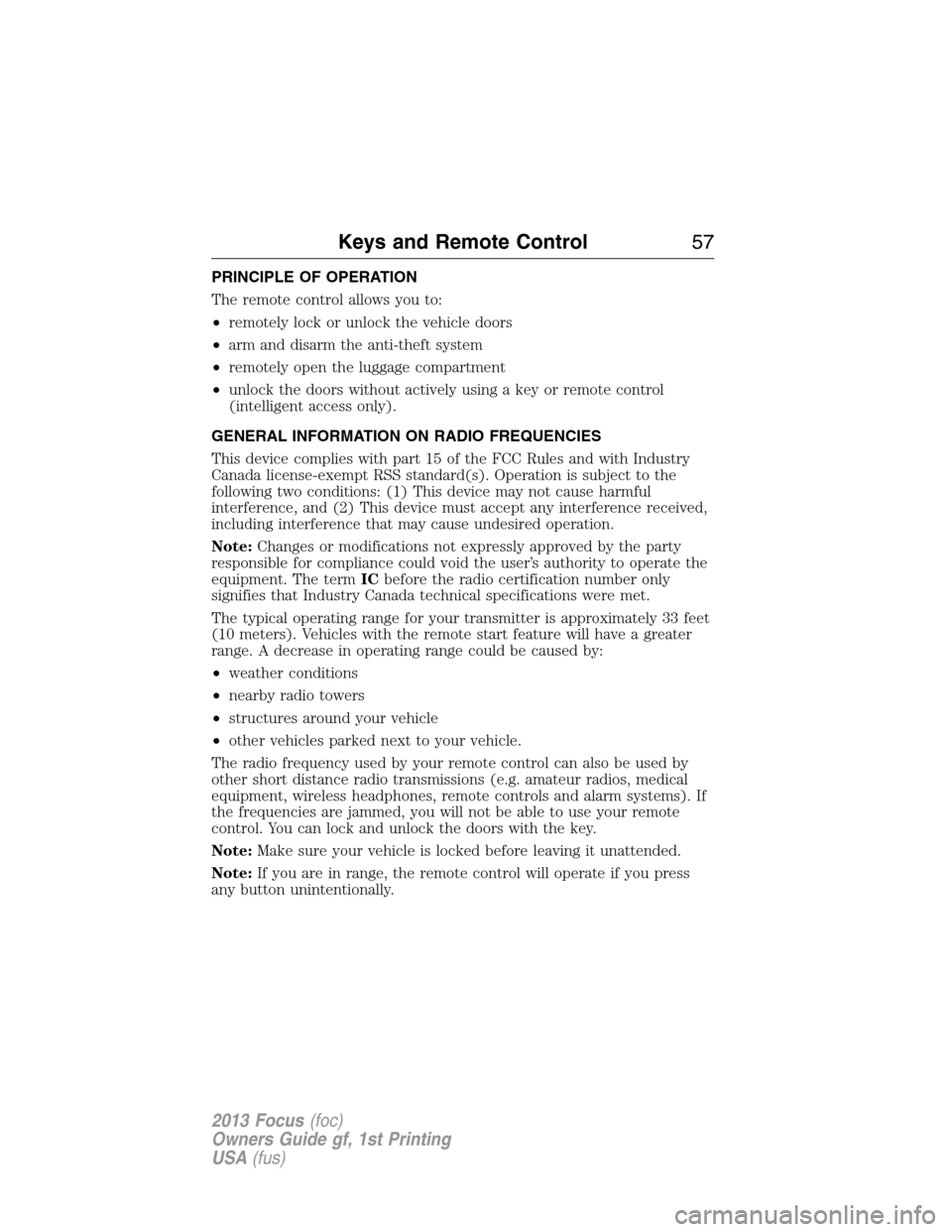
PRINCIPLE OF OPERATION
The remote control allows you to:
•remotely lock or unlock the vehicle doors
•arm and disarm the anti-theft system
•remotely open the luggage compartment
•unlock the doors without actively using a key or remote control
(intelligent access only).
GENERAL INFORMATION ON RADIO FREQUENCIES
This device complies with part 15 of the FCC Rules and with Industry
Canada license-exempt RSS standard(s). Operation is subject to the
following two conditions: (1) This device may not cause harmful
interference, and (2) This device must accept any interference received,
including interference that may cause undesired operation.
Note:Changes or modifications not expressly approved by the party
responsible for compliance could void the user’s authority to operate the
equipment. The termICbefore the radio certification number only
signifies that Industry Canada technical specifications were met.
The typical operating range for your transmitter is approximately 33 feet
(10 meters). Vehicles with the remote start feature will have a greater
range. A decrease in operating range could be caused by:
•weather conditions
•nearby radio towers
•structures around your vehicle
•other vehicles parked next to your vehicle.
The radio frequency used by your remote control can also be used by
other short distance radio transmissions (e.g. amateur radios, medical
equipment, wireless headphones, remote controls and alarm systems). If
the frequencies are jammed, you will not be able to use your remote
control. You can lock and unlock the doors with the key.
Note:Make sure your vehicle is locked before leaving it unattended.
Note:If you are in range, the remote control will operate if you press
any button unintentionally.
Keys and Remote Control57
2013 Focus(foc)
Owners Guide gf, 1st Printing
USA(fus)
Page 58 of 475
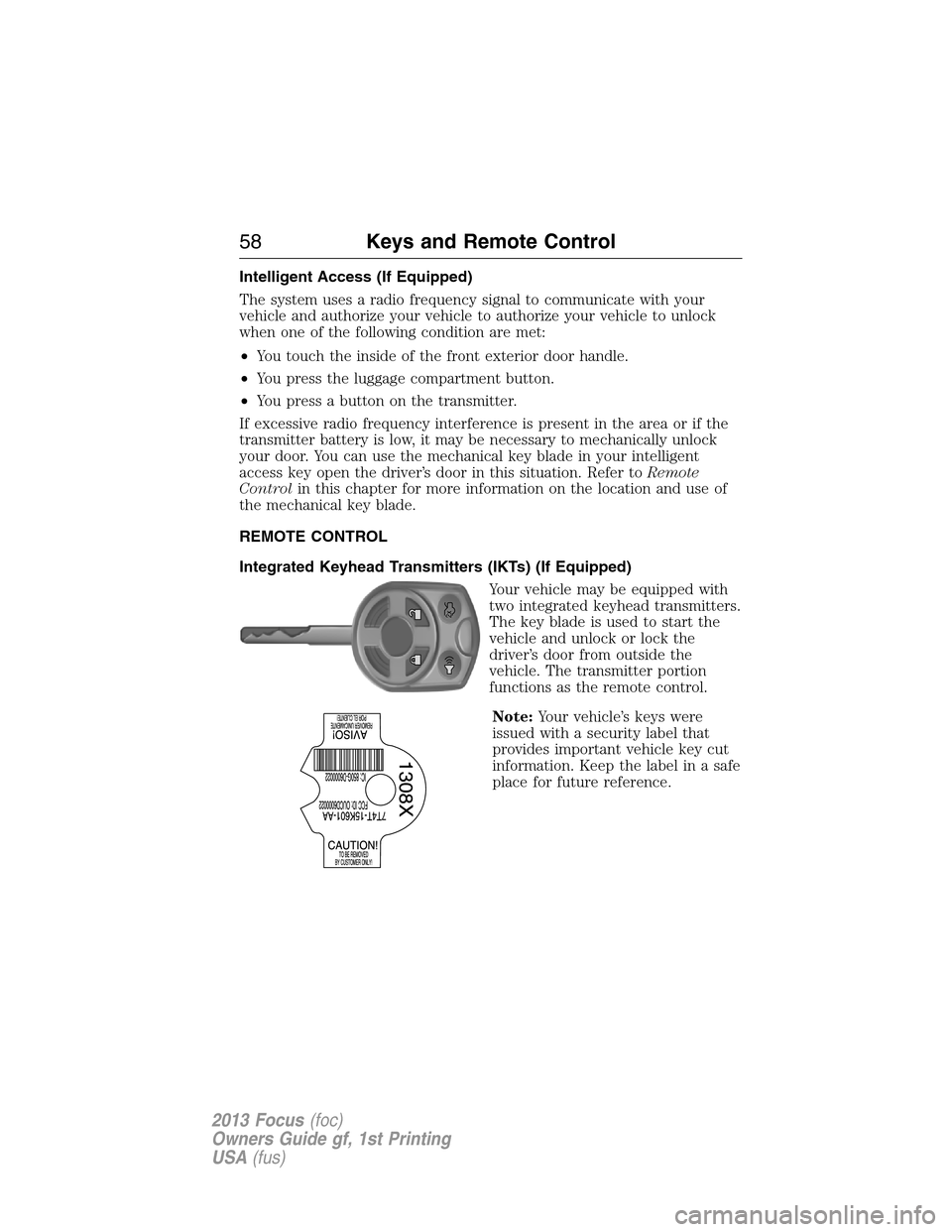
Intelligent Access (If Equipped)
The system uses a radio frequency signal to communicate with your
vehicle and authorize your vehicle to authorize your vehicle to unlock
when one of the following condition are met:
•You touch the inside of the front exterior door handle.
•You press the luggage compartment button.
•You press a button on the transmitter.
If excessive radio frequency interference is present in the area or if the
transmitter battery is low, it may be necessary to mechanically unlock
your door. You can use the mechanical key blade in your intelligent
access key open the driver’s door in this situation. Refer toRemote
Controlin this chapter for more information on the location and use of
the mechanical key blade.
REMOTE CONTROL
Integrated Keyhead Transmitters (IKTs) (If Equipped)
Your vehicle may be equipped with
two integrated keyhead transmitters.
The key blade is used to start the
vehicle and unlock or lock the
driver’s door from outside the
vehicle. The transmitter portion
functions as the remote control.
Note:Your vehicle’s keys were
issued with a security label that
provides important vehicle key cut
information. Keep the label in a safe
place for future reference.
58Keys and Remote Control
2013 Focus(foc)
Owners Guide gf, 1st Printing
USA(fus)
Page 59 of 475
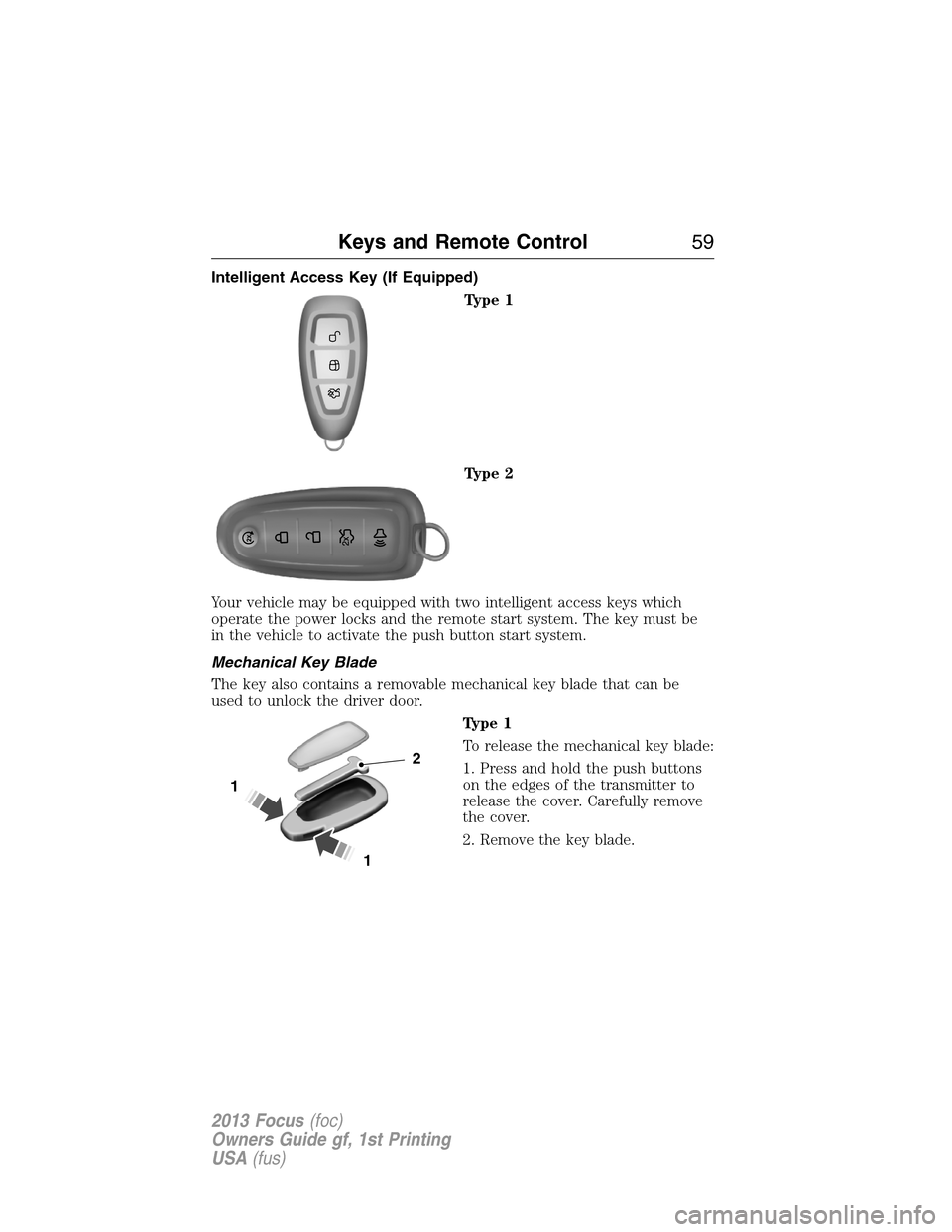
Intelligent Access Key (If Equipped)
Type 1
Type 2
Your vehicle may be equipped with two intelligent access keys which
operate the power locks and the remote start system. The key must be
in the vehicle to activate the push button start system.
Mechanical Key Blade
The key also contains a removable mechanical key blade that can be
used to unlock the driver door.
Type 1
To release the mechanical key blade:
1. Press and hold the push buttons
on the edges of the transmitter to
release the cover. Carefully remove
the cover.
2. Remove the key blade.
1
1
2
Keys and Remote Control59
2013 Focus(foc)
Owners Guide gf, 1st Printing
USA(fus)
Page 60 of 475
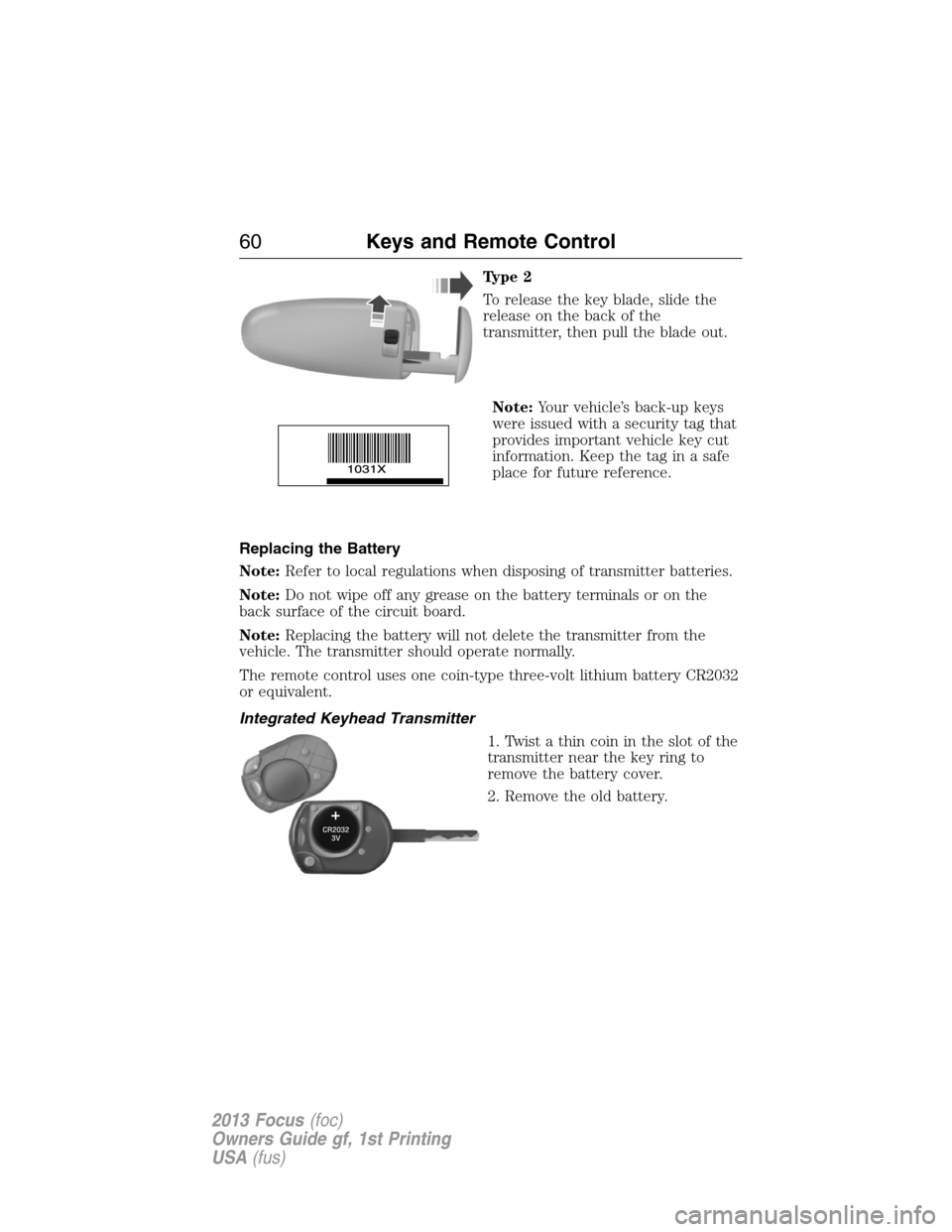
Type 2
To release the key blade, slide the
release on the back of the
transmitter, then pull the blade out.
Note:Your vehicle’s back-up keys
were issued with a security tag that
provides important vehicle key cut
information. Keep the tag in a safe
place for future reference.
Replacing the Battery
Note:Refer to local regulations when disposing of transmitter batteries.
Note:Do not wipe off any grease on the battery terminals or on the
back surface of the circuit board.
Note:Replacing the battery will not delete the transmitter from the
vehicle. The transmitter should operate normally.
The remote control uses one coin-type three-volt lithium battery CR2032
or equivalent.
Integrated Keyhead Transmitter
1. Twist a thin coin in the slot of the
transmitter near the key ring to
remove the battery cover.
2. Remove the old battery.
60Keys and Remote Control
2013 Focus(foc)
Owners Guide gf, 1st Printing
USA(fus)